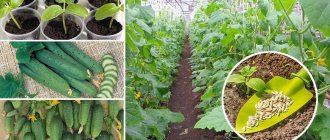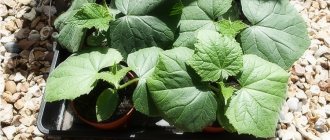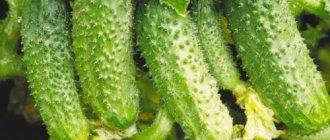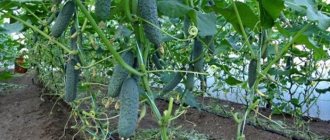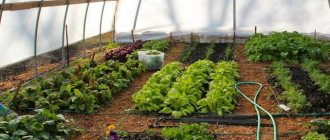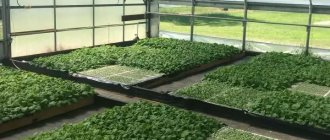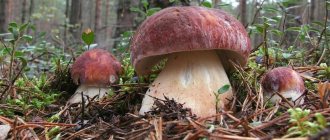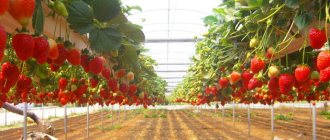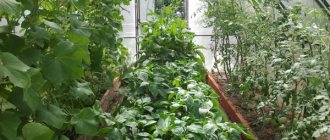Necessary equipment
One of the important issues for a gardener is the choice of greenhouse and its location. The greenhouse is chosen so that it is spacious in size and provides vegetables for the whole family. The optimal ratio of volume to area is 2:1. The height in the greenhouse should be on average 2 meters (more towards the center, less at the sides). The average height of the ridge is 2.5 meters.
A lower height is undesirable, since cucumber vines grow to 3-3.5 meters during the season. And it is not advisable to do it higher, since the air will warm up more slowly. The greenhouse must have a ventilation system. Ideally, it would be automatic.
The greenhouse is placed on a flat surface or with a slight slope to the south. The direction of the greenhouse is the same: from north to south, for better lighting of the plants. A container is placed in the greenhouse to water the cucumbers only with warm water.
Problems and their solutions
Cucumbers in a greenhouse can get sick, be attacked by insects, and for some unknown reason their leaves may turn yellow and the ovaries may fall off. Each of these problems requires a solution.
If the leaves and ovaries of a cucumber turn yellow
The leaves and ovaries of cucumbers can turn yellow for various reasons. But the most likely ones:
- Plants do not have enough lighting, especially the lower part of the plants, which are in the shade. Yellowed leaves must be carefully cut off, freeing up space for light.
- Watering too much and the roots suffocate without oxygen.
- Insufficient watering of plants.
- Lack or excess of fertilizers.
- The temperature in the greenhouse is below 14°C for a long time.
- Cold water is used for irrigation.
Video: preventing yellowing of leaves on cucumbers
Diseases of cucumbers in a greenhouse
No more than 2-3 plants should grow on one square meter of bed in a greenhouse. Otherwise, fungal diseases may develop on cucumbers, which spread very quickly in dense thickets and are difficult to control. Cucumbers get sick from drafts, so ventilation of the greenhouse must be done very carefully. The most common diseases found in greenhouses are:
- bacteriosis;
- anthracnose;
- root rot.
Diseases must be prevented by carrying out preventive spraying of plants once every 14 days with the drug Fitosporin, which is harmless to humans, but copes well with pathogens of fungal diseases.
At the first signs of the disease, it is necessary to remove and burn the damaged leaves, and spray the inside of the bushes, frame and covering of the greenhouse with a pink solution of potassium permanganate. Ventilate the greenhouse well, remove thickening leaves and shoots.
Photo gallery: what causes cucumbers in a greenhouse
The leaves of cucumbers infected with bacteriosis become covered with ulcerations and gradually dry out. The fruits of a plant infected with bacteriosis. The roots of cucumbers infected with root rot decompose and the plant dies. Cucumbers infected with root rot quickly dry out. Cucumbers of a plant infected with anthracnose become covered with ulcerations. Anthracnose on cucumber fruits is manifested not only by external ulcers ami, but and the inside of the fruit is also affected by Anthracnose on cucumber leaves
Pests
The most dangerous insects:
- Spider mite, a small insect that settles on the underside of a leaf. Sucks juices from it. It can affect cucumbers in a greenhouse only with poorly organized watering. Loves heat and dry air. At high humidity, which cucumbers love, it rarely settles. But if infection does occur, treatment with drugs that are non-toxic to humans and have a short decay period will help: Fitoverm, Akarin (Agrovertin), Bitoxibacillin, etc. Treatments must be carried out at intervals of 10–14 days.
Spider mites weaken the plant and transmit viral diseases - The cucumber mosquito is brought into the greenhouse with manure, but more often with onions, in whose scales it overwinters. The damage is significant. If infested heavily, it can destroy the crop. The larvae settle in the base of the stem and roots, gnawing spiral-shaped tunnels in them. The fight against it comes down to preventive measures: disinfecting the soil in the beds by watering with a boiling pink solution of potassium permanganate. If infection does occur, watering the beds with a solution of ammonia (1 ml per 5 liters of water) will help.
Cucumber mosquito larvae settle at the base of the stem and roots of cucumbers, causing their death - Aphids not only suck juices from a colonized plant, but also spread viral diseases. Infection most often occurs with the help of ants that feed on the sweet liquid secreted by aphids. Spraying the leaves with a solution of Bitoxibacillin and Fitoverm works well. You can spray the foliage with a solution of ammonia (1 ml per 5 liters of water).
Settling on young leaves and shoots, aphids suck out the juices and weaken the plant
Choosing a variety for indoor soil
Self-pollinating or parthenocapic cucumber varieties are suitable for indoor soil. Both do not need bees. Plants set fruit in closed ground conditions without external intervention. But the process of ovary formation itself occurs in different ways.
Self-pollinating cucumbers are those in which pollination occurs as a result of pollen being transferred from the stamens to the pistil within one flower. In this case, the plant does not have female and male flowers, and accordingly, there are no barren flowers.
Parthenocapic is translated as “virgin”, that is, the cucumber sets without pollination. In adulthood, parthenocapic fruits are always distinguished by their appearance. They have virtually no seeds. And if they exist, they are very tiny, in their infancy.
Among self-pollinating varieties there are varieties and hybrids. The variety differs from a hybrid in that it is a fairly stable form that transmits its basic qualities through the seeds. If you buy a variety of cucumber once, you can plant it year after year, collecting the seeds yourself. Its varietal characteristics will be preserved.
Currently, hybrids are more common; they are designated in their names as F1. Such cucumbers do not transmit their qualities through seeds, so gardeners have to buy them every year. If this is not done, then splitting occurs in the second generation, and it is not known exactly what characteristics will appear as a result.
Let's consider several popular varieties and hybrids for greenhouses and greenhouses:
- Adam F1. Dutch self-pollinating high-yielding hybrid. Valued for setting fruit very early. In just a month and a half you can start harvesting. The second undoubted advantage is the extended fruiting period. Cucumbers are arranged 5-7 together. With insufficient care, 2-4 fruits are tied in the knot. Cucumbers grow not only beautiful in appearance: dark, small, with small thorns. They are delicious both prepared and fresh.
- Zyatek F1. A very popular parthenocapic hybrid. It is loved for its early ripening, the first fruits appear already on the 40th day. The bouquet arrangement of the ovaries is also appreciated. The cucumbers of this hybrid are gherkin-type, cylindrical in shape. They do not grow large; growth stops at 14-16 cm. The fruits of this variety are tasty and productive.
- F1 is the envy of everyone. Despite the fact that this hybrid appeared relatively recently, it has already become popular among gardeners due to its super-yielding and bunched arrangement of fruits. The variety's lashes are powerful. They develop right up to frost and produce an excellent harvest on the side shoots. The thin skin makes it possible to use these fruits both fresh and pickled.
- Well-fed dad F1. One of the salad varieties for indoor soil. Long, smooth, cylindrical fruits are suitable for salad and fresh consumption. This variety is not suitable for whole-fruit canning, but it is just right for preparing lecho and other preparations where chopped fruits are needed. Just like the previous ones, this variety has bunched ovaries, is early ripening and disease resistant.
- Ecole F1. One of the new, very successful parthenocapic hybrids. This cucumber is suitable for those who can preserve pickles (greens 3-6 cm). That is why it can be picked within 35-38 days after the first shoots appear. Ecole's greens are smooth, cylindrical, and grow in bunches. They are collected every day so that they do not overgrow.
- Chinese cold-resistant F1. From the popular series of long and sweet cucumbers. It is suitable for growing in greenhouses, where it is easier to tie it up. Its lashes are powerful and grow quickly. The fruits themselves reach half a meter in length. Smooth and tasty cucumbers can be used in salads or prepared into slices for the winter.
The labels on the bags of cucumbers “Parthenocapic (self-pollinating)” are incorrect. A variety or hybrid can be one or the other. Most often we are talking about parthenocapics.
Advantages of greenhouse vegetable growing
Cucumbers are undoubtedly one of the most common and favorite vegetables among gardeners. Along with growing this crop in open ground, the use of greenhouses is becoming increasingly common. And this is not surprising. Compliance with correct agricultural technology is a big plus for the greenhouse option of growing cucumbers in front of open ground.
Advantages of greenhouse cultivation:
- the yield from the same area is several times higher;
- possibility of getting an early harvest;
- extension of the growth of this vegetable in the middle zone until the beginning of October;
- the use of cucumber varieties zoned for the southern regions.
Using the right varieties of cucumbers and the technology of cultivating them in a greenhouse, and special technical means to maintain optimal temperature and humidity, it is possible to grow this vegetable all year round in the middle zone.
If desired, by growing cucumbers in a greenhouse, gardeners can obtain the harvest for personal consumption and start a fairly profitable home business.
The only disadvantages can be considered the financial costs of manufacturing or purchasing the greenhouse itself and investing a lot of physical effort.
You can grow cucumbers in a heated greenhouse all year round
Soil preparation
The preparatory planting process begins with the soil. If you grow cucumbers through seedlings, then first you need to prepare or buy a special mixture in which you will plant the seeds.
Cucumbers love loose and fertile soil, which means that they need the same soil for sowing seeds. The soil should not only be light, but also moisture-retaining, which is very important for cucumbers who like to “drink.” That is why it is better to exclude peat from the composition or use it in small quantities. Store-bought soil, which most often contains a lot of peat, begins to dry out quickly at home.
Watch the acidity, it is peat that has an acidic reaction. In order for cucumbers to develop normally, the pH level should be approximately 6.5-7.
Composition of the substrate for cucumber seedlings:
- turf soil - 3 parts;
- humus or fully matured compost - 2 parts;
- sand - 1 part.
This mixture must be sifted so that there are no large parts. The mixture can be heated in the oven for 10-20 minutes or frozen. It is best to prepare the mixture in advance, in the fall, and put it in a bag. Place the bag on the balcony to kill pathogens. Before sowing, add a liter of vermiculite to the mixture bucket for looseness, a glass of ash and 2 tablespoons of superphosphate.
Problems likely to occur when growing cucumbers
There are several of them. Let's consider each separately, as well as the reasons and possible solutions. So:
The branches of the lower part are drying
This happens due to lack of moisture in hot summers. Compared to the problems with the lower tier, the upper one looks quite normal and even pleases with the ovaries. We proceed as follows:
- little by little, day by day, remove the leaves from below;
- roll the stem into a ring and lay it on the ground;
- carefully “fasten” it to the ground with a wire fork so that the top, with all the leaves and flowers, remains higher;
- We provide watering and maintenance.
In diseased plants, the ovaries turn yellow and fall off long before they fully ripen.
After a while, the deep part of the stem will begin to grow a root, and everything will return to normal.
Ovaries do not form
Bundle varieties of cucumbers, like hybrids, produce abundant harvests. Each node contains up to 7 ovaries, but some may turn yellow and fall off before they begin to grow. There are several reasons for this:
- too humid and/or hot;
- there are less than 10% male flowers on the bush;
- a large number of ripe fruits on the vines;
- insects do not arrive and pollinate plants due to bad weather;
- few nutrients in the soil.
The first problem can be solved by reducing watering and ventilation. The last one is feeding with a mixture of cow dung and urea, and when it comes to adult cucumbers, you just need to remove them on time. This is done daily as the fruit grows.
Important! Do not allow cucumbers to grow more than 12 cm in length and 5 cm in thickness. When the lashes are covered with green giants, all the nutrition goes to them, so new ovaries are not formed.
Fruits grow poorly
A “poultice” will help: on a sunny day, water the greenhouse, as well as the plants and soil, and then close it for an hour. Ventilate carefully, without drafts.
Poultices should be used with caution.
Bitter taste
This happens even with normal watering, and the culprit is the substance cucurbitacin, which is responsible for the taste. Its volume in a vegetable is determined by growing conditions, characteristics of the variety, and duration of ripening.
Important! The longer the period from pollination to a full-fledged cucumber (the norm is 8 to 12 days), the more bitterness it will contain.
Properly preparing seeds for sowing
Previously, before germination, gardeners performed a procedure such as heating the seeds. This is long-term heating of dry seeds near heating devices at a temperature of 30-35 degrees.
Such events have a positive effect on increasing the formation of female flowers in all pumpkin plants.
When preparing self-pollinating and parthenocapic hybrids for sowing, the seeds do not need to be heated, since they do not have the problem of forming barren flowers.
Nowadays, seeds that have already been treated with thiram are often sold. Information is contained on the packaging. The seeds are colored poisonous green as a warning about the toxicity of the applied substance. Thiram is a fungicide that is used against a complex of diseases. Such seeds are not soaked or germinated.
If you have ordinary seeds, then they need to be treated with some kind of fungicide or a saturated solution of potassium permanganate. When there are many varieties, you need to put them in gauze bags and place them in the prepared solution for 15-20 minutes.
After this, you need to wash the seeds and start germination. Germination does not affect the yield, but avoids planting empty seeds.
Before germination, the seeds should be placed in a small amount of water for several hours or overnight to swell. The water should cover the seeds a little so that they do not “suffocate”. There is no need to harden cucumbers because they do not have the cold tolerance gene.
Advantages of the seedling method:
- allows you to get results earlier than when sowing seeds;
- the plant will grow and become stronger in comfortable conditions;
- sorting is possible: you can see which plants develop better and which worse;
- some seeds do not germinate immediately or freeze during seedling growth.
Plants of the same height will be easier to care for. The rest can be planted in a corner so that plants of the same type grow in one place. Such measures will allow you to get an early and healthy harvest.
Male and female flowers: what is the difference and what are they needed for
Their main difference is that the former have stamens, but are barren flowers, while the latter lack pollen, but produce ovaries. Pollination is necessary for fruit formation, so both “girls” and “boys” are needed. At the same time, when there are too many “guys”, their number can be reduced.
Active formation of female flowers occurs at the beginning of the vegetative process, especially if the temperature is slightly reduced. Smoke also contributes to their appearance, so vegetable growers periodically “smoke” the beds.
Male and female cucumber flowers.
There are always more male inflorescences on the main stem than on the lateral ones. Their number increases with abundant watering, as well as in the case of growing seedlings from seeds of last year's harvest. Planting density also matters: when there are more than 5 plants per square meter, the percentage of male flowers increases.
Growing seedlings
In order for growing seedlings to become an advantage, you need to try to do it correctly. Cucumbers ready for planting should not be overgrown, strong, and without signs of disease. The ideal option is 3-4 sheets.
For sowing, take separate cups at once so that the root system is formed correctly. If this is not possible, then seeds are planted in trays at a distance of 5-10 cm from each other. Seeds must be properly prepared and germinated. The sprouts are small, so-called “beaks”, so as not to break them.
Before planting, the hole in which the seed is placed is spilled with hot water and a weak solution of potassium permanganate. Sprinkle the cucumber seed on top with loose soil in a 2 cm layer.
If possible, cover the container with cucumbers with a damp rag or plastic bag for 1-3 days until seedlings appear.
Preparing soil in a greenhouse
Cucumbers love loose and fertile soil. This is what fertile loams are. Clay is too heavy for them and lacks breathability. The sand is loose, but it does not hold water, and without it, cucumbers will not grow. As a last resort, sandy loam is suitable, to which you can add a little heavy clay soil to balance the composition.
In a greenhouse, you need to prepare the soil in advance. You can plant green manure immediately after harvesting vegetables, and dig up with them before frost. The best option would be mustard greens. It will disinfect the soil and enrich it with valuable microelements.
With the onset of winter, you need to throw snow into the greenhouse so that in the spring moisture saturates the soil. After all the snow has melted, the soil in the greenhouse is dug up. The holes must be prepared in advance before planting seedlings. The ideal option is warm ridges, because cucumber is a very heat-loving crop.
They can be made both in autumn and spring. If this is not possible, then humus or compost mixed with ash and double superphosphate is placed in the prepared furrows or holes: half a glass of superphosphate and a liter of ash per bucket. Then sprinkle with 10-20 cm of loose soil.
If you change the soil in the greenhouse in the fall or spring, then you should take into account that you need to take the soil from those areas where the day before you grew vegetables that do not have common diseases with cucumbers: cabbage, onions, carrots, peppers or potatoes.
Transplanting
Seedlings are planted in the ground when the soil temperature reaches 15°C. This is a very important point. The air temperature in the greenhouse is important, but of secondary importance. Although any shelter for growing cucumbers should be equipped with a thermometer.
Cucumbers love warmth, and soil temperature is especially important to them. For objectivity, you need to take measurements in the morning. Experienced gardeners cover the place where the temperature will be measured with a board or plywood so that the place is not heated by the sun.
A thermometer is placed under the shelter to a depth of approximately 20 cm and left for 15-30 minutes. This way you get a fairly objective result. In order for the soil to heat up faster, it can be covered with plastic film, and also a warm ridge can be made.
But it starts to work only at a certain temperature, so you first need to spill it with hot water and then cover it with film. To activate biofuel on cold days, you will have to do this several times before the start of the season.
We plant seedlings like this. First, we make a hole in the hole already filled with fertilizers the size of the cucumber’s root system. We leave the distance between future plants about 40-60 cm. Then you need to pour warm water with the addition of a weak solution of potassium permanganate for disinfection.
The seedlings must be buried to the cotyledon leaves or the first true one. The soil around is compacted a little, and the surrounding area can be sprinkled with dry soil.
You can additionally mulch the beds with cucumbers to retain heat in the soil.
Pest and disease control
Although in greenhouses, compared to growing in open areas, cucumbers are more protected from diseases and pest invasions, preventive measures must be taken. And if diseases occur or plants are damaged by pests, take the necessary measures to save the plants.
Table: disease and pest control
| Diseases and pests of cucumbers | Signs of damage | Prevention and control measures |
| Powdery mildew. | White coating on the leaves. | Prevention:
Treatment:
|
| Root rot | The stems at the roots become brown and dry. The leaves also become spotted and fall to the ground. Growth is delayed and the bush may die. | Prevention:
Treatment: disinfection of stem roots and soil with a solution - 3 tsp. copper sulfate and 6 tbsp. l. Dilute ash in 1 liter of water. |
| Anthracnose | Yellowish-brown formations on leaves and fruits. |
|
| Spider mite. | Sucks juice from leaves - flowers and ovaries fall off, the plant may die. | Prevention: weed control. Fighting mites: treating plants with water with the addition of garlic. |
| Greenhouse whitefly. | It sucks the juice out of plants - white sugary traces remain. | Prevention:
Treatment: washing the bottom of the damaged leaf with water. |
| Melon aphid. | Wrinkling and curling of leaves, flowers are affected. | Prevention: weed control. Treatment: infuse 30 g of red pepper and 200 g of tobacco dust in 10 liters of water (60°C) for 24 hours. Add soap and 3 tablespoons of ash. Spray 1–2 liters per 1 m2 for a week. |
The table shows the main diseases and pests of cucumbers when growing them in a greenhouse. It should be borne in mind that compliance with the basic rules for cultivating this crop, starting from preparing a greenhouse, planting seeds for seedlings and ending with harvesting, will save the plants from the threat of infection by diseases or damage by pests.
Photo gallery: diseases and pests of cucumbers
Powdery mildew of cucumbers - white, floury coating on the leaves
Root rot of cucumbers - dried stems and roots Anthracnose of cucumbers - brown spots on leaves
Greenhouse whitefly leaves sugary traces on leaves
Melon aphid on cucumbers
Cucumber bush affected by spider mites
Optimal conditions for the growth of cucumbers
There is a reason why cucumbers and tomatoes are planted separately. Although some manage to get good results by growing them together. Cucumbers need special conditions to grow and have a good harvest: light, heat, humidity, watering and others. The growing conditions for cucumbers are almost the same as for all pumpkins.
Watering
Cucumber is a very responsive crop to watering. It must be regular, without this the harvest will not be good. In dry years, it may not exist at all, since the water is instantly absorbed by the soil. Watering in a greenhouse or hotbed should be done frequently; the leaves should not be allowed to wilt.
This feature is associated with the structure of the cucumber root system. It is located close to the soil surface, so the plant does not have the opportunity to take water from the depths, as, for example, tomatoes do. The health of the plant depends on how often you water it. In hot weather, when fruits are forming, this should be done every day.
Cucumbers are recommended to be irrigated using the sprinkling method. With this method, water is poured out in small drops, partially evaporating. This increases the air humidity in the greenhouse, which is very important for cucumbers. The soil is gradually saturated with water, which allows the roots to better absorb moisture.
Water consumption per 1 m2 is approximately 15-25 liters per day or every other day, depending on the weather. When fruits form, water consumption increases and amounts to 20-30 liters.
Do not water cucumbers with cold water. They used to say that this makes the fruits bitter. Now the fruits are genetically sweet, but cold water is not advisable for watering because it increases the likelihood of plant disease.
Feeding
We must not forget about fertilizing. Cucumbers grow rapidly, and modern hybrids produce very high yields. In order for the plant to be able to “feed” them, it is necessary to apply fertilizer 1-2 times a month, literally from the first days.
Fertilizers are organic and mineral. Organic are natural fertilizers. These include manure, green fertilizer from grass, ash, and chicken droppings. When growing seedlings, only ash is used from the listed fertilizers when preparing the substrate for sowing seeds.
Before planting in the ground, seedlings are fed 1-2 times with mineral fertilizers. Preference is given to nitrogen or complex ones with a predominance of nitrogen, because first the plant must increase its green mass and become stronger.
After planting in the ground, cucumbers are not fed for 2 weeks until the plant has completely taken root. In addition, there is usually enough nutrition in the holes. After this, you need to start “feeding” green fertilizer, a solution of mullein, chicken droppings and ash. From the beginning of flowering, potassium fertilizers are added.
Light mode
The time of fruiting, as well as the yield of cucumbers, depends on the intensity of light and the length of daylight hours. The second has a greater effect on plant growth. Cucumbers are short-day plants, so they need a 10-12 hour day to fully develop. During the period of growing seedlings, this is no less important. If there is not enough light, then conditions of 10-hour daylight hours are created using artificial lighting.
Temperature
Cucumber is a very heat-loving crop. If it's cold outside, you can't expect good harvests. In addition, the plants will be weakened, which will affect the increase in morbidity. The average temperature in the greenhouse should be maintained at 17°C. But for the first time after sowing, the temperature should be 25-28 degrees.
That's why it's better to grow cucumbers at home first. Severe cold spells have a negative impact on growth. But too high temperatures are also harmful to cucumbers.
If on hot days the temperature in the greenhouse is above 30C, then you need to ventilate and spray the plant to reduce the temperature.
Humidity
Cucumber has an increased need for air humidity. For cucumbers, this norm is 85-95%. If you compare it with peppers, the difference is very big. Peppers need a moisture content of 60-65%. At low humidity, the process of pollination and fruit set is significantly reduced.
Of the greenhouse crops, cucumber is perhaps the most moisture-demanding crop.
Ventilation
At first, when the cucumber seedlings are still small, you need to ventilate the rooms where they grow very carefully. Cucumbers do not tolerate drafts at all. And in the greenhouse it is necessary to ventilate, especially when the thermometer rises above 30C.
The windows are opened only on one side to avoid drafts.
Bush formation
In order for cucumbers to produce a bountiful harvest and bear fruit for a long time, the plant must be shaped correctly. There are a lot of opinions on this matter, but the overwhelming majority believes that formation is necessary.
Topping
Pinch the cucumber vines as follows:
- the first 40-50 cm - the shoots “blind” completely;
- pinch the next 40-50 cm above the first leaf;
- the next 40-50 cm above the second;
- then 40-50 cm above the third;
- and so on.
Some gardeners cut off the plants' tendrils to save energy. For the same purpose, not all ovaries are left; some are removed. If it is noticed that when fruits are formed in bunches, some do not have enough nutrition and they begin to dry out, then one fruit at a time is left in the axils. In this case, watering and fertilizing are increased.
It turns out like a “herringbone” in reverse. At the end of growth, under the roof, the plants set fruits freely. Some people pinch the whip under the roof so that it does not waste energy on growth. All potential is spent on the formation of fruits.
It has been noticed that without pinching, the yield is significantly reduced.
Stepsoning
Stepsons on cucumbers are only appropriate when the stepsons are removed at the beginning of growth, half a meter above the soil surface. There is no need to do this higher, since many large ovaries are located on the side shoots. The meaning of pinching is that the plant’s forces are released for further growth and development.
For this procedure, carefully bend the leaf and remove the shoot with a cloth or knives. Subsequently, the leaves at the bottom of the vine dry out and the main stem becomes bare. There are many root primordia on it. If you lay the stem in a ring, roots will begin to grow very quickly in this place and the cucumber will have additional nutrition.
Tying up
Cucumbers are tied up in a greenhouse for the following reasons:
- plants in this position are better illuminated by the sun;
- the lashes are ventilated and the cucumbers get sick less;
- they are easier to care for;
- plants do not intertwine with each other;
- Almost 100% of flowers and ovaries are preserved;
- watering and loosening are simplified;
- good visibility when picking fruit.
You need to start tying up the plant at one month of age, when its height reaches 30-40 cm. There are several types of materials from which ropes for cucumbers are made. Everyone chooses the best option for themselves. For some it is rags, for others it is nylon. Some people opt for synthetic twines, which are sold in hardware stores.
The length of one twine is 2-2.5 meters. One end is attached to the ceiling, and the other should freely go down. The lower end is carefully attached between the lower leaves. As the lash grows, it wraps clockwise around the twine.
Top dressing
During the entire growing season, cucumbers need to be fed. Different types and rates of organic and mineral fertilizers are used in different growing cycles. During the season, plants are fed at least four times.
Table: feeding cucumbers during the season
| Fertilizer application time | Types and rates of applied fertilizers |
| After planting the seedlings. | In infused mullein (1 glass per 10 liters of water) dissolve 10–15 g of superphosphate and potassium sulfate. |
| Before flowering. | Same |
| At the beginning of fruiting. | Nitrophoska solution (10–15 grams per 10 liters of water). |
| During mass fruiting. | A solution of 0.5 liters of mullein and 1 tsp. potassium sulfate per 10 liters of water. |
The fertilizer rates indicated in the table are applied at the rate of 0.5 liters per plant.
Wood ash is a very valuable fertilizer for cucumbers. It is diluted in a ratio of 100 g per 10 liters of water and used at any time during plant cultivation with a break of 10 days.
Video: how to properly feed cucumbers
Harvesting
Oddly enough, the regularity of harvesting affects the harvest itself. If cucumbers are not picked on time, they grow and develop further. The plant spends nutrients on them. Especially a lot of microelements go into the formation of seeds.
Therefore, the greens are collected when they reach a size of 10-15 cm. They are picked carefully, holding the whip with one hand so as not to damage them.
During the period when plants begin to bear fruit en masse, cucumbers are harvested once every 1-2 days, depending on the area of the greenhouse.
All diseased, dry and crooked fruits are removed without waiting for them to grow, as they deplete the plant.
Formation of a cucumber bush
Parthenocarpic cucumber hybrids that do not require pollination grow best in greenhouses. To obtain a generous harvest and long-term fruiting, cucumber bushes must be properly shaped. Since female flowers with ovaries in hybrids are located on the central shoot, the plants form into one stem. Up to the fourth leaf, all stepsons and ovaries are removed from the vine. This method is called "blinding". Then the stepsons pinch up to the eighth leaf, leaving only one ovary per leaf. For the next four leaves, two ovaries and two leaves are left on the stepsons, etc. When the vine grows to the top of the greenhouse, the top is thrown over the crossbar and allowed to grow freely down until a distance of 1 m remains to the soil. Then the top is pinched.
Forming cucumber bushes is a creative endeavor. Nothing bad will happen if the stepsons and ovaries are removed not to 4, but to 5 leaves, etc. The main thing is not to thicken the plants so that they have enough nutrition and light. Some vegetable growers do not remove the shoots and do not pinch the vines, growing cucumbers on mesh trellises, and attach each new shoot to the cells, distributing them evenly. And they also get high yields.

